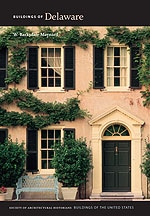
Brandywine Creek was a crucible of the Industrial Revolution in the United States, and several early mill buildings survive along its rocky banks. Modern condominiums occupy the remains of this snuff and flour mill purchased in 1845 by Jessup and Moore and converted to papermaking, a trade that originated in the United States on the Brandywine in 1787 (see Rockland Mills, BR36). In 1898, Augustine Mills produced 50,000 pounds of fine book and printing paper a day. Container Corporation of America made sixty tons of paperboard here daily in the 1940s, and the plant remained in operation in the 1970s. A survey during that decade showed seven nineteenth-century mill buildings of brick and stone existing in the complex, some with original iron trusses. The oldest building lay farthest north and alone was spared demolition when the site was redeveloped as high-rise residences, Brandywine Park Condominiums (1983–1984, Homsey Architects).














